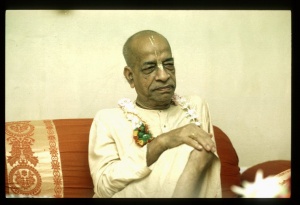CC Madhya 20.145: Difference between revisions
m (1 revision(s)) |
No edit summary |
||
| Line 1: | Line 1: | ||
{{ | [[Category:Sri Caitanya-caritamrta - Madhya-lila Chapter 20|C145]] | ||
<div style="float:left">'''[[Sri Caitanya-caritamrta|Śrī Caitanya-caritāmṛta]] - [[CC Madhya|Madhya-līlā]] - [[CC Madhya 20|Chapter 20: Lord Śrī Caitanya Mahāprabhu Instructs Sanātana Gosvāmī in the Science of the Absolute Truth]]'''</div> | |||
<div style="float:right">[[File:Go-previous.png|link=CC Madhya 20.144|Madhya-līlā 20.144]] '''[[CC Madhya 20.144|Madhya-līlā 20.144]] - [[CC Madhya 20.146|Madhya-līlā 20.146]]''' [[File:Go-next.png|link=CC Madhya 20.146|Madhya-līlā 20.146]]</div> | |||
{{CompareVersions|CC|Madhya 20.145|CC 1975|CC 1996}} | |||
{{RandomImage}} | |||
==== TEXT 145 ==== | ==== TEXT 145 ==== | ||
<div | <div class="verse"> | ||
vyāmohāya carācarasya jagatas te te purāṇāgamās | :vyāmohāya carācarasya jagatas te te purāṇāgamās | ||
tāṁ tām eva hi devatāṁ paramikāṁ jalpantu kalpāvadhi | :tāṁ tām eva hi devatāṁ paramikāṁ jalpantu kalpāvadhi | ||
siddhānte punar eka eva bhagavān viṣṇuḥ samastāgama- | :siddhānte punar eka eva bhagavān viṣṇuḥ samastāgama- | ||
vyāpāreṣu vivecana-vyatikaraṁ nīteṣu niścīyate | :vyāpāreṣu vivecana-vyatikaraṁ nīteṣu niścīyate | ||
</div> | </div> | ||
| Line 14: | Line 18: | ||
==== SYNONYMS ==== | ==== SYNONYMS ==== | ||
<div | <div class="synonyms"> | ||
''vyāmohāya''—to increase the illusion and ignorance; ''cara-acarasya''—of all living entities, moving and nonmoving; ''jagataḥ''—of the world; ''te te''—those respective; ''purāṇa''—the supplementary Vedic literatures called the ''Purāṇas''; ''āgamāḥ''—and ''Vedas''; ''tām tām''—that respective; ''eva hi''—certainly; ''devatām''—demigod; ''paramikām''—as supreme; ''jalpantu''—let them speak about; ''kalpa-avadhi''—until the end of the millennium; ''siddhānte''—in conclusion; ''punaḥ''—but; ''ekaḥ''—one; ''eva''—only; ''bhagavān''—Supreme Personality of Godhead; ''viṣṇuḥ''—Lord Viṣṇu; ''samasta''—all; ''āgama''—of the Vedas; ''vyāpāreṣu''—in the dealings; ''vivecana-vyatikaram''—to collective consideration; ''nīteṣu''—when forcibly brought; ''niścīyate''—is established. | |||
</div> | </div> | ||
| Line 21: | Line 25: | ||
==== TRANSLATION ==== | ==== TRANSLATION ==== | ||
<div | <div class="translation"> | ||
“‘There are many types of Vedic literatures and supplementary Purāṇas. In each of them there are particular demigods who are spoken of as the chief demigods. This is just to create an illusion for moving and nonmoving living entities. Let them perpetually engage in such imaginations. However, when one analytically studies all these Vedic literatures collectively, he comes to the conclusion that Lord Viṣṇu is the one and only Supreme Personality of Godhead.’ | “‘There are many types of Vedic literatures and supplementary Purāṇas. In each of them there are particular demigods who are spoken of as the chief demigods. This is just to create an illusion for moving and nonmoving living entities. Let them perpetually engage in such imaginations. However, when one analytically studies all these Vedic literatures collectively, he comes to the conclusion that Lord Viṣṇu is the one and only Supreme Personality of Godhead.’ | ||
</div> | </div> | ||
| Line 28: | Line 32: | ||
==== PURPORT ==== | ==== PURPORT ==== | ||
<div | <div class="purport"> | ||
This is a verse from the Padma Purāṇa. | This is a verse from the ''Padma Purāṇa''. | ||
</div> | </div> | ||
__NOTOC__ | |||
<div style="float:right; clear:both;">[[File:Go-previous.png|link=CC Madhya 20.144|Madhya-līlā 20.144]] '''[[CC Madhya 20.144|Madhya-līlā 20.144]] - [[CC Madhya 20.146|Madhya-līlā 20.146]]''' [[File:Go-next.png|link=CC Madhya 20.146|Madhya-līlā 20.146]]</div> | |||
__NOTOC__ | |||
__NOEDITSECTION__ | |||
Revision as of 12:30, 6 September 2021

A.C. Bhaktivedanta Swami Prabhupada
TEXT 145
- vyāmohāya carācarasya jagatas te te purāṇāgamās
- tāṁ tām eva hi devatāṁ paramikāṁ jalpantu kalpāvadhi
- siddhānte punar eka eva bhagavān viṣṇuḥ samastāgama-
- vyāpāreṣu vivecana-vyatikaraṁ nīteṣu niścīyate
SYNONYMS
vyāmohāya—to increase the illusion and ignorance; cara-acarasya—of all living entities, moving and nonmoving; jagataḥ—of the world; te te—those respective; purāṇa—the supplementary Vedic literatures called the Purāṇas; āgamāḥ—and Vedas; tām tām—that respective; eva hi—certainly; devatām—demigod; paramikām—as supreme; jalpantu—let them speak about; kalpa-avadhi—until the end of the millennium; siddhānte—in conclusion; punaḥ—but; ekaḥ—one; eva—only; bhagavān—Supreme Personality of Godhead; viṣṇuḥ—Lord Viṣṇu; samasta—all; āgama—of the Vedas; vyāpāreṣu—in the dealings; vivecana-vyatikaram—to collective consideration; nīteṣu—when forcibly brought; niścīyate—is established.
TRANSLATION
“‘There are many types of Vedic literatures and supplementary Purāṇas. In each of them there are particular demigods who are spoken of as the chief demigods. This is just to create an illusion for moving and nonmoving living entities. Let them perpetually engage in such imaginations. However, when one analytically studies all these Vedic literatures collectively, he comes to the conclusion that Lord Viṣṇu is the one and only Supreme Personality of Godhead.’
PURPORT
This is a verse from the Padma Purāṇa.